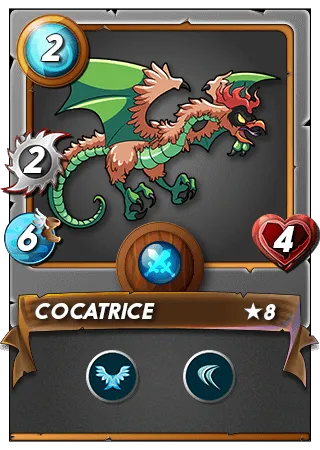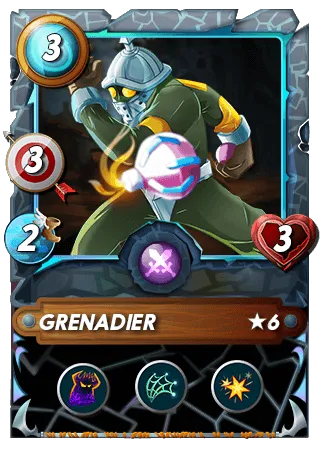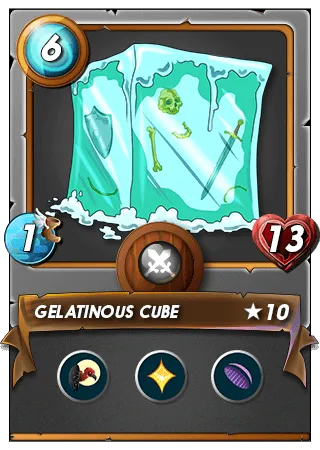Hey guys, I'm the hollowknightgod and I wanted to bring a deep dive into the whole space of abilities and mechanics inside the gameplay of Splinterlands. There's a lot information inside the game about them, but there's too much nuance in the gameplay itself and many abilities become umbiguous or unintelligible. My focus is on those, but let's start with two little mechanics: missing chance and attack order.
 Blind gives -15% accuracy for the enemy team. (15% missing chance)
Blind gives -15% accuracy for the enemy team. (15% missing chance)
 The dodge ability gives you a 25% chance of dodging an attack
The dodge ability gives you a 25% chance of dodging an attack
 The flying ability gives you a 25% as well, but only against non-flying monsters
The flying ability gives you a 25% as well, but only against non-flying monsters
Take the example of Cocatrice.

Against any melee or ranged attack that has no flying ability, Cocatrice has already a 50% chance of dodging the attack.
The last relevant thing to take into consideration is Speed, which gives you a 10% chance of dodging per unit of difference in speed.
Regarding attack order, while I was researching about it I found this post from @bulldog1205, and he does an outstanding job, make sure to check it out. Because of that I won't lose time with it and we can keep on because there's so much more still.
Abilties
Afliction, Poison, Retaliate and Stun have a 50% chance of happening each attack.




Healing gives HP equal to 1/3 of your maxHP rounded DOWN. The minimum heal is 2.

Last Stand and Enrage both multiply your stats by 1.5x rounding up in the end. Enrage gives you extra speed and damage, while Last Stand gives you speed, damage and HP.


Repair gives +2 armor to the unit that has lost the most armor.

Attack vs Damage Dealt
Now, to continue I'll need to touch on a few concepts that are not explicit inside the game, but are necessary to understand how some abilities work. We must make the distinction of Attack and Damage Dealt. Attack is the damage a monster does to another while damage dealt is how much of it was inflicted in the receving monster. Most times the attack and damage dealt are the very same number, but no always. Take Lord of Darkness for instance.

Although he has 4 attack, if he attacked another Lord of Darkness he would not cause 4 damage on it. That is the distinction, although simple, is very important.
Life Leech gives the attacking monster 1/2 of the Damage Dealt by it rounded up.

Void and Shield reduce the damage dealt by the attacking monsters by half, always rounding it up. Void for magic, Shield for ranged and melee attacks. Both have one exception, when the attack is 1 -> damage dealt is 0. Shield reduces the damage of throns as well, from the capped 2 damage to 1 damage.


Blast is one of my favorite abilities, and it does damage to adjacent monsters equal to half the attack of the monster rounded up.

The adjacent damage is not reduced if the main target have an ability that reduces damage. Here I wanna share with you a curious case. I was playing with Grenadier and I ended up hitting a Gelatinous Cube.


By doing so I activated the oppress ability that states that the attacking monster does double damage when attacking a monster that has no attacks. In my mind I would do 6 damage to the Cube but the blast damage would be the usual 2 damage that Grenadier provides. Surprise, surprise when my Grenadier did 4 blast damage, and the very simple explanation is that Grenadier does not do double damage on the unit he is hitting that has no attacks, but instead because the unit has no attacks, he does double his own damage. Meaning that he literally attacks for 6 when he hits the Cube. I thought that interaction quite cute and wanted to share with you guys.
Return Fire and Magic Reflect follow the same mathematical rule. They reflect half of the attack of the opponent monster rounded up.


Interactions
If the Trample ability procs and the monster that died is ressurected, the monster tramples and attacks no the first monster after ressurection, but the second monster of the opponent's formation.

Sneak, Opportunity, and Snipe are in certain rule sets conflicting abilities. You may find yourself confused with many combinations of the above, but there is a clear hierarchy between them and it works like this:
 Sneak reigns supreme. If you have sneak, it WILL attack the back line.
Sneak reigns supreme. If you have sneak, it WILL attack the back line.

 Opportunity is clearly supperior to Snipe!
Opportunity is clearly supperior to Snipe!
Final Thoughts
I hope I offered you value by bringing these abilities more clarity, and I'll leave a link down for anynone that wants to start in Splinterlands and haven't yet. You guys are missing a great, fun, and real #play2earn game!
https://splinterlands.com?ref=hollowknightgod
If you guys liked the content I'll ask you to follow because I'll be bringing solid content every time, and to be honest I'm constantly learning how to improve the looks and content of my blog. Thank you for reading so far and have a great experience in Splinterlands!
